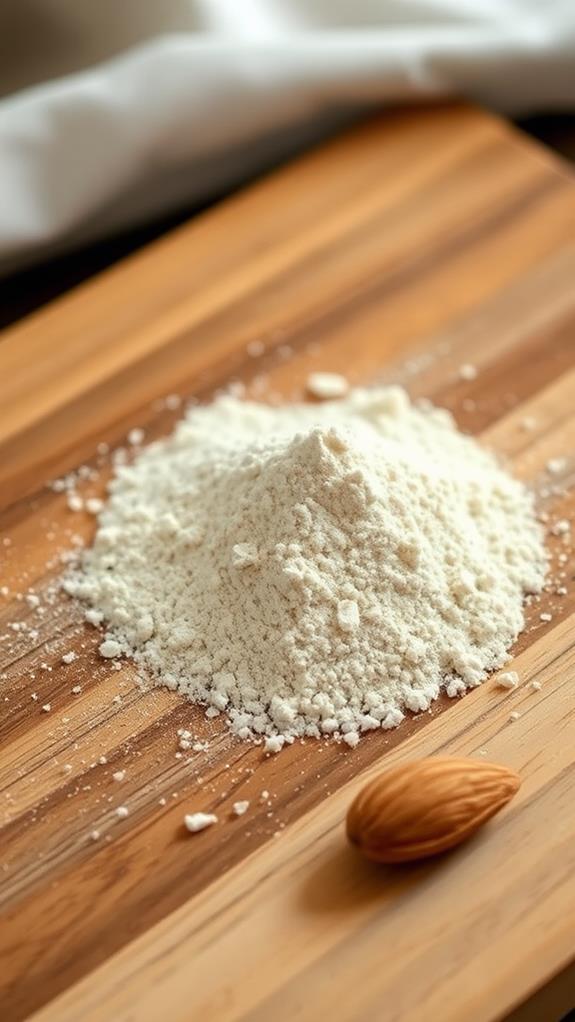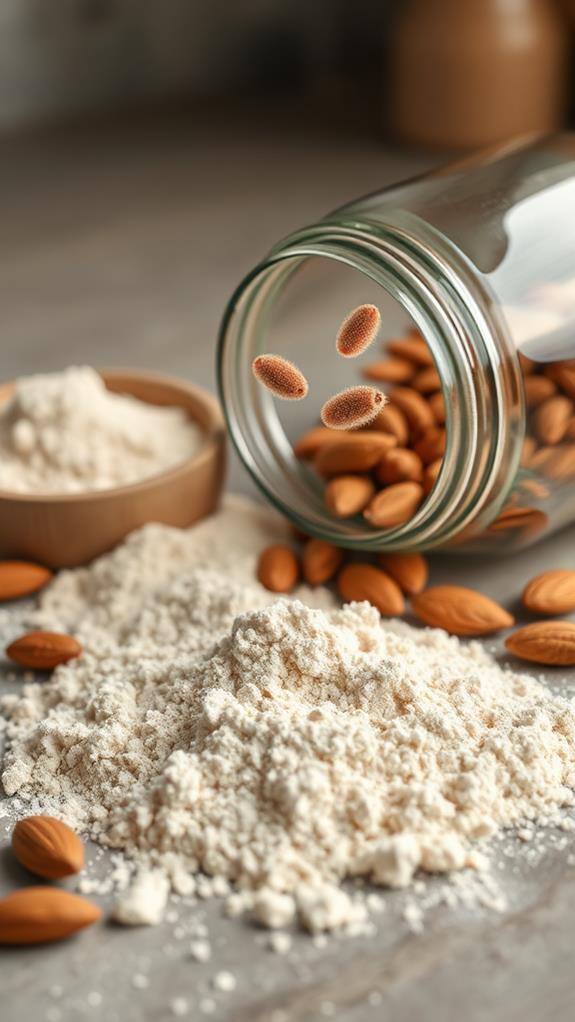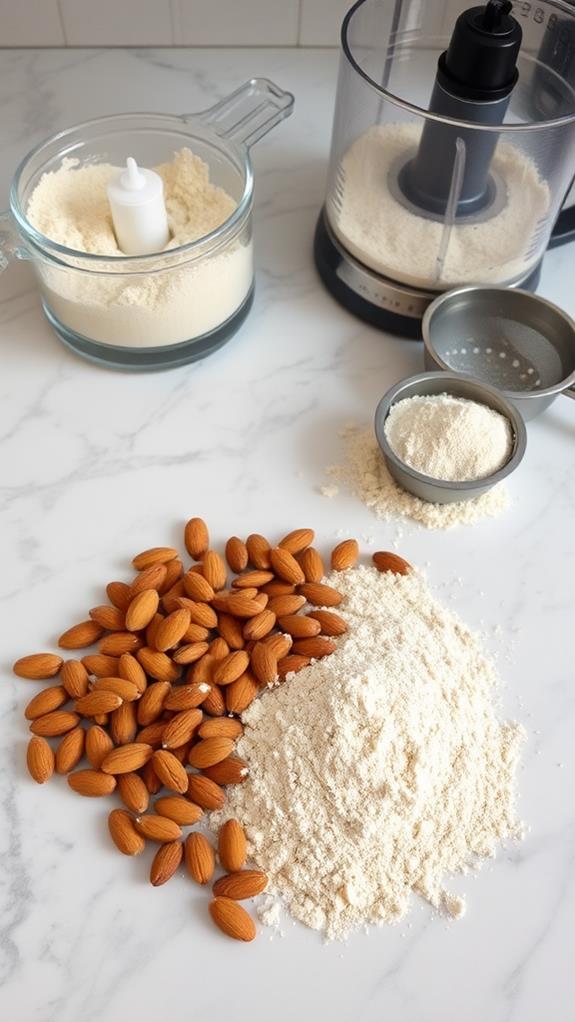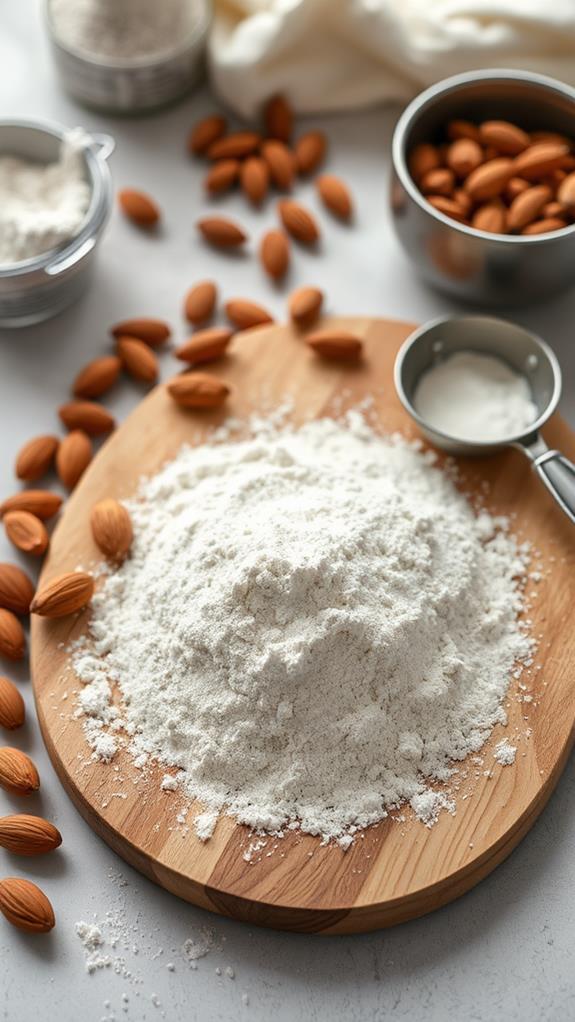Is Almond Flour Safe to Eat Raw
Almond flour is generally safe to eat raw, but you should be aware of potential risks. While it's a nutrient-dense food rich in protein, healthy fats, and fiber, raw almond flour may contain harmful bacteria like Salmonella or E. coli. Proper storage and handling are vital to minimize contamination risks. Heat-treating or using almond flour in cooked recipes can effectively eliminate these risks. Raw consumption may also lead to digestive discomfort due to higher levels of phytic acid. However, almond flour offers numerous health benefits, including being a complete protein source and providing essential vitamins and minerals. To fully understand the safety considerations and maximize the benefits, it's important to explore further.
This post may contain affiliate links. If you make a purchase through these links, I may earn a commission at no additional cost to you. Additionally, portions of this post may be generated using artificial intelligence (AI) technology. While we strive for accuracy, please be aware that AI-generated content may not always be perfect and should be fact-checked when necessary.
The Spatula Scoops
- Almond flour is generally safe to eat raw but carries a small risk of bacterial contamination.
- Proper storage and handling are crucial to minimize potential contamination risks.
- Raw almond flour undergoes pasteurization to reduce harmful bacteria, enhancing safety.
- Consuming large amounts of raw almond flour may cause digestive discomfort in some individuals.
- Cooking or baking with almond flour effectively eliminates potential risks associated with raw consumption.
What Is Almond Flour

Almond flour is a versatile, gluten-free alternative to traditional wheat flour. It's made by blanching almonds to remove the skin, then grinding them into a fine powder. You'll find that this flour has a slightly sweet, nutty flavor and a moist texture, making it popular in both baking and cooking. Like corn-derived sweeteners, almond flour has gained popularity as an alternative ingredient in various recipes, offering unique properties and nutritional benefits.
When you're working with almond flour, you'll notice it's lower in carbohydrates and higher in protein and healthy fats compared to wheat flour. This nutritional profile makes it a favorite among those following low-carb, paleo, or keto diets. Almond flour is also rich in vitamin E, magnesium, and manganese.
In terms of culinary applications, you can use almond flour in a wide range of recipes. It's excellent for making grain-free breads, cookies, cakes, and even as a coating for meats or vegetables. However, because it lacks gluten, you'll need to adjust your recipes when substituting it for wheat flour. Often, you'll add more binding agents like eggs or xanthan gum to achieve the desired texture in baked goods.
Nutritional Profile of Almond Flour
When you explore into the nutritional profile of almond flour, you'll find it's packed with beneficial nutrients. This gluten-free alternative to wheat flour is rich in protein, healthy fats, and essential vitamins and minerals. For every 1/4 cup (28 grams) of almond flour, you're getting about 6 grams of protein, 14 grams of fat (mostly monounsaturated), and 3 grams of fiber. Much like cacao powder, almond flour is versatile and can be used in various recipes, from baked goods to savory dishes. It's also a great option for those following specific dietary requirements, such as vegan or keto diets.
Almond flour is an excellent source of vitamin E, a powerful antioxidant that supports immune function and skin health. It also contains magnesium, which is essential for bone health and energy production. You'll find manganese in almond flour too, supporting bone formation and metabolism. The flour is naturally low in carbohydrates, making it a popular choice for those following low-carb or ketogenic diets.
It's worth noting that almond flour is calorie-dense, with about 160 calories per 1/4 cup. While it's nutrient-rich, you'll want to be mindful of portion sizes if you're watching your calorie intake. Despite its high calorie content, the nutritional advantages of almond flour make it a valuable addition to a balanced diet.
Potential Risks of Raw Consumption

When consuming raw almond flour, you should be aware of potential risks. Bacterial contamination is a concern, as almonds can harbor harmful microorganisms if not properly processed. Similar to raw corn safety, thorough washing and proper storage are vital to minimize contamination risks. You'll also encounter higher levels of phytic acid in raw almond flour, which may interfere with nutrient absorption. Additionally, eating large amounts of raw almond flour can put stress on your digestive system, potentially leading to discomfort or other gastrointestinal issues.
Bacterial Contamination Concerns
In light of potential bacterial contamination, consuming raw almond flour isn't without risks. While almonds undergo pasteurization to reduce harmful bacteria, the milling process can introduce new contaminants. You should be aware that raw almond flour may harbor pathogens like Salmonella or E. coli, which can cause foodborne illnesses.
These bacteria thrive in moist environments, and although almond flour is dry, improper storage or exposure to humidity can create conditions for bacterial growth. It's essential to store your almond flour in a cool, dry place and check for any signs of moisture or clumping. Remember, even if the flour looks and smells fine, harmful bacteria may still be present.
To minimize risks, consider heat-treating raw almond flour before consumption. This process involves spreading the flour on a baking sheet and heating it in the oven at a low temperature for a short period. This step can effectively eliminate potential pathogens without considerably altering the flour's nutritional profile or taste. Alternatively, using almond flour in recipes that involve cooking or baking is a safer option, as the heat will kill any harmful bacteria present.
Phytic Acid Content
Almond flour's phytic acid content presents another consideration when consuming it raw. Phytic acid is an antinutrient found in many plant-based foods, including almonds. When you eat raw almond flour, you're exposing yourself to higher levels of this compound compared to cooked or processed versions.
Phytic acid can bind to minerals like iron, zinc, and calcium in your digestive tract, potentially reducing their absorption. This means that while almond flour is nutrient-dense, you might not be getting the full benefit of its mineral content when eaten raw. However, it is crucial to recognize that phytic acid isn't all bad. Some studies suggest it may have antioxidant properties and could help lower cholesterol levels.
If you're concerned about phytic acid, you can reduce its levels by soaking, sprouting, or lightly roasting almonds before grinding them into flour. These processes can help break down some of the phytic acid. Alternatively, you could balance your diet by consuming almond flour alongside foods rich in vitamin C, which can enhance mineral absorption despite the presence of phytic acid.
Digestive System Stress
How might raw almond flour affect your digestive system? While almond flour is generally considered safe, consuming it raw may cause some digestive stress. Your body isn't accustomed to processing large amounts of raw nuts, which can lead to gastrointestinal discomfort.
Raw almond flour contains enzyme inhibitors that can interfere with your digestive enzymes. These inhibitors are naturally present in almonds to prevent premature sprouting. When you eat raw almond flour, these inhibitors can make it harder for your body to break down proteins, fats, and carbohydrates effectively. This may result in bloating, gas, or indigestion.
Additionally, the high fiber content in almond flour can be challenging for some people to digest when consumed raw. Fiber is beneficial for digestion when eaten in moderation, but a sudden increase in raw almond flour intake might overwhelm your digestive system, leading to cramping or diarrhea.
To mitigate these potential issues, consider lightly toasting your almond flour before use. This process can help neutralize enzyme inhibitors and make the flour more digestible, reducing the likelihood of digestive stress.
Benefits of Eating Raw Almond Flour
When you consume raw almond flour, you're tapping into a nutrient powerhouse that offers several health benefits. You'll get a protein-rich food source that's also packed with healthy fats, making it an excellent option for those following various dietary plans. Additionally, the high fiber content in raw almond flour can aid your digestion and help you feel fuller for longer periods.
Nutrient-Dense Protein Source
One of the most compelling reasons to consume raw almond flour is its impressive protein content. This nutrient-dense powder packs a powerful punch, offering you a concentrated source of plant-based protein. When you incorporate raw almond flour into your diet, you're not just adding flavor and texture to your meals; you're also boosting your protein intake considerably.
Raw almond flour provides several key benefits as a protein source:
- Complete amino acid profile: It contains all nine essential amino acids your body can't produce on its own.
- High bioavailability: Your body can easily absorb and utilize the protein from almond flour.
- Versatility: You can add it to smoothies, yogurt, or sprinkle it on salads for a protein boost.
- Sustained energy: The protein in almond flour helps maintain stable blood sugar levels.
Healthy Fats Content
Beyond its impressive protein profile, raw almond flour boasts a wealth of healthy fats that can substantially benefit your overall health. You'll find a high concentration of monounsaturated fats, particularly oleic acid, which is known for its heart-protective properties. These fats can help lower bad cholesterol levels and reduce your risk of cardiovascular disease.
Raw almond flour also contains omega-3 and omega-6 fatty acids, essential for brain function and inflammation regulation. Here's a breakdown of the healthy fats you'll find in raw almond flour:
| Fat Type | Benefits | Daily Value (per 1/4 cup) |
|---|---|---|
| Monounsaturated | Heart health, cholesterol reduction | 7g |
| Polyunsaturated | Brain function, inflammation control | 3g |
| Omega-3 | Cognitive health, anti-inflammatory | 0.01g |
| Omega-6 | Skin health, metabolism support | 3g |
Fiber-Rich Digestive Aid
Raw almond flour packs a powerful punch when it comes to fiber content, making it an excellent digestive aid. When you consume raw almond flour, you're providing your body with a significant amount of insoluble fiber, which helps promote regular bowel movements and prevents constipation. This fiber also acts as a prebiotic, feeding the beneficial bacteria in your gut and supporting overall digestive health.
The fiber in raw almond flour offers several benefits for your digestive system:
- Slows digestion, helping you feel fuller for longer
- Reduces the risk of gastrointestinal disorders
- Aids in nutrient absorption
- Helps maintain a healthy gut microbiome
Processing Methods and Safety Considerations

Throughout the production of almond flour, several processing methods are employed to guarantee its safety for consumption. You'll find that most commercially available almond flour undergoes pasteurization, a process that eliminates harmful bacteria. This step involves exposing the almonds to heat or steam, effectively reducing the risk of foodborne illnesses.
After pasteurization, the almonds are typically blanched to remove the skins, then ground into a fine powder. This grinding process can be done using various methods, including cold-pressing or high-speed milling. It's essential to recognize that while these processes enhance safety, they don't completely sterilize the product.
When considering raw consumption, you should be aware that even processed almond flour may contain trace amounts of bacteria. While the risk is low, it's not zero. If you're immunocompromised or have concerns, it's best to consult with a healthcare professional. Additionally, proper storage is pivotal to maintain the flour's safety. Keep it in an airtight container in a cool, dry place to prevent moisture and potential mold growth. By understanding these processing methods and safety considerations, you can make informed decisions about consuming raw almond flour.
Proper Storage and Handling
To maintain the quality and safety of your almond flour, proper storage and handling are essential. Store your almond flour in an airtight container to prevent moisture and contaminants from entering. Keep it in a cool, dry place away from direct sunlight and heat sources. Refrigeration can extend its shelf life, but ensure it's well-sealed to prevent absorbing odors from other foods.
When handling almond flour, follow these guidelines:
- Use clean, dry utensils and containers to prevent contamination
- Avoid cross-contamination by keeping it separate from other ingredients
- Check for signs of spoilage, such as rancid odors or discoloration
- Always use the "first in, first out" method to rotate your stock
It is pivotal to pay attention to the expiration date on the packaging. While almond flour can last several months when stored properly, it can go rancid due to its high fat content. If you're uncertain about its freshness, perform a quick smell test. Rancid almond flour will have a sour or off-putting odor. By following these storage and handling practices, you'll guarantee your almond flour remains safe and of high quality for your culinary endeavors.
Culinary Uses for Raw Almond Flour

Almond flour's versatility shines in its raw form, offering numerous culinary applications. You'll find it's an excellent ingredient for no-bake recipes, where its nutty flavor and fine texture can enhance various dishes. For instance, you can use raw almond flour as a base for energy balls, protein bars, or raw desserts like cheesecakes and tarts.
In smoothies and shakes, raw almond flour acts as a thickener and protein booster. It's also a great addition to overnight oats or chia puddings, providing extra nutrients and a subtle almond taste. For those following a raw food diet, almond flour serves as a key component in raw crackers, bread, and pie crusts.
You can incorporate raw almond flour into savory dishes too. It works well as a coating for raw vegetable "meatballs" or as a binder in raw veggie burgers. Additionally, you can use it to create raw nut cheese spreads or as a garnish for salads and soups. Remember, when using raw almond flour, it's vital to source high-quality products to guarantee food safety and ideal flavor.
Expert Recommendations and Guidelines
While raw almond flour offers numerous culinary applications, it's important to ponder expert recommendations and guidelines for its consumption. Food safety experts and nutritionists generally agree that raw almond flour is safe to eat, but they advise taking certain precautions.
When considering raw almond flour consumption, keep these expert recommendations in mind:
- Purchase from reputable sources: Acquire you're buying high-quality almond flour from trusted manufacturers to minimize the risk of contamination.
- Store properly: Keep your almond flour in an airtight container in a cool, dry place to prevent moisture and bacterial growth.
- Check for signs of spoilage: Before using, inspect the flour for any unusual odors, discoloration, or clumping.
- Use within recommended timeframes: Consume opened packages within 2-3 months for ideal freshness and safety.
It's worth noting that while raw almond flour is generally safe, some experts recommend heat-treating it to eliminate any potential pathogens. This process, known as pasteurization, can be done at home by spreading the flour on a baking sheet and heating it in the oven at 165°F (74°C) for 10 minutes. This step isn't mandatory but can provide an extra layer of food safety assurance.
Frequently Asked Questions
Can Almond Flour Be Used as a Substitute for Wheat Flour in Baking?
Yes, you can use almond flour as a substitute for wheat flour in baking. It's a popular choice for gluten-free and low-carb diets. However, keep in mind that almond flour has different properties than wheat flour. It's denser and more moist, so you'll need to adjust your recipes. You may need to use less liquid and add a binding agent like xanthan gum. Almond flour works well in cookies, cakes, and quick breads, but it's not ideal for yeast-based recipes.
Does Almond Flour Have a Strong Nutty Flavor?
Imagine a forest where every tree whispers its unique flavor. In this culinary woodland, the almond tree stands tall, its essence captured in flour form. You'll find that almond flour does indeed have a nutty flavor, but it's not overpowering. It's a subtle, slightly sweet taste that can enhance your baked goods. The intensity can vary depending on the almonds used and how they're processed. You'll notice it more in recipes where it's a primary ingredient.
How Long Does Homemade Almond Flour Last?
When you make almond flour at home, it'll typically last about 2-4 weeks in an airtight container at room temperature. If you store it in the refrigerator, you can extend its shelf life to 4-6 months. For even longer storage, consider freezing it, which can keep it fresh for up to a year. Always check for signs of spoilage, like an off smell or mold, before using. Proper storage is key to maintaining your homemade almond flour's freshness and quality.
Is Almond Flour Suitable for People With Nut Allergies?
No, almond flour isn't suitable for people with nut allergies. If you're allergic to tree nuts, including almonds, you should avoid almond flour entirely. It's made from ground almonds, which can trigger severe allergic reactions in sensitive individuals. Even if you're only allergic to certain nuts, it's best to consult with your allergist before consuming almond flour. They might recommend complete avoidance or suggest alternatives like coconut flour or sunflower seed flour for your baking needs.
Can Almond Flour Be Used in Savory Dishes?
You'd think almond flour's only for sweets, but it's surprisingly versatile in savory dishes too. You can use it as a gluten-free breading for chicken or fish, mix it into meatballs for added texture, or even use it to thicken sauces. It's great for low-carb diets and adds a subtle nutty flavor to your cooking. Try incorporating it into crusts for quiches or as a binder in veggie patties. Just remember, a little goes a long way in savory recipes.
Conclusion
As you've journeyed through the almond flour landscape, you've uncovered its nutritional riches and potential risks. Like a double-edged sword, raw almond flour offers benefits but requires careful handling. You're now equipped to make informed choices about its consumption and storage. Remember, while raw almond flour can be a versatile ingredient, it's crucial to ponder processing methods and expert guidelines. By balancing safety with culinary creativity, you can confidently incorporate this nutty treasure into your diet.





